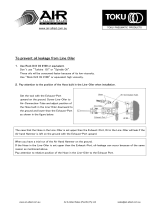
Chain Saws with Chain Brake
Greenlee Tools, Inc. 4455 Boeing Dr. • Rockford, IL 61109-2988 USA • 815-397-7070
14
Maintenance
Wear eye protection when operating
or servicing this tool.
Failure to wear eye protection could
result in serious eye injury from ying
debris or hydraulic oil.
Do not change accessories, inspect, adjust or
clean tool when it is connected to a power source.
Accidental startup can result in serious injury.
Failure to observe this warning could result in severe
injury or death.
SCHEDULE
Use this schedule to maximize the tool’s service life.
Notes:
Keep all decals clean and legible. Replace decals when
necessary. See the Specifications and Parts manual for
decal part numbers.
When disposing of any components (hydraulic hoses,
hydraulic fluid, worn parts, etc.), do so in accordance
with federal, state and local laws or ordinances.
Daily
1. Wipe all tool surfaces clean.
2. Inspect the entire chain before use. Tension and
sharpen the chain as instructed under Saw Chain and
Bar Maintenance. An improperly sharpened, dull, worn
or damaged chain increases the risk of kickback.
3. Check the operation of the automatic oiler before
use as instructed under Checking and Setting the
Automatic Chain Oiler. An improperly set oiler can
accelerate the wear of the chain and bar.
4. Inspect the hydraulic hoses and ttings for signs
of leaks, cracks, wear or damage. Replace if
necessary.
5. Install dust caps over the hydraulic ports when the
tool is disconnected.
Monthly
1. Perform a thorough inspection of the hydraulic
hoses and ttings as described in publication
99930323, SAE J1273 (Hose and Hose Assemblies).
2. Perform the Bar Service procedure as described
under Saw Chain and Bar Maintenance.
Annually
If required by your organization, have the tool inspected
by an Greenlee Authorized Service Center.
STORAGE
Wipe all tool surfaces clean of oil and wood particles.
Check for worn chain and bar as well as for loose,
broken, or damaged chain saw components. Adjust or
replace as necessary.
Install an appropriate guide bar sheath or scabbard,
and store in a location to preclude accidental contact or
damage.
CHECKING AND SETTING
THE AUTOMATIC CHAIN OILER
The automatic chain oiler provides a constant supply of
oil to lubricate the bar and chain whenever the saw is
operating. An adjustment screw controls the amount of
oil supplied.
1. Run the saw at full rpm.
2. If the tip of the saw gives off a ne spray of oil, the
automatic oiler is working properly. If the saw does
not give off a spray of oil, adjust the oiler.
Note: For better results, hold saw so that the tip of
the saw blade is pointing toward a clean sheet of
paper or cardboard and run the saw at full rpm. If
the automatic oiler is working properly, the paper or
cardboard should soon show small droplets of oil.
3. Stop the hydraulic power source.
4. Twist the adjustment screw 1/2 turn as follows:
• clockwise to decrease the oiler output.
• counterclockwise to increase the oiler output.
Figure 13 Automatic Oiler Adjustment Screw
Automatic Oiler
Adjustment Screw
5. Start the hydraulic power source.
6. Repeat until the oiler output is adjusted correctly.
























